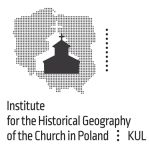Marek Słoń (English Version)
ORCID: 0000-0001-8208-4743 email: marek.slon@kul.pl
Employment
Institute for the Historical Geography of the Church in Poland KUL, Associate Professor at the John Paul II Catholic University of Lublin (KUL)
Academic resume
I studied history at the University of Warsaw (1986-91), and I prepared my master's thesis entitled Religious Life in Late Medieval Lviv under the supervision of Prof. Andrzej Poppe. I then undertook doctoral studies (1993-98) at the Institute of History at the Polish Academy of Sciences. I defended my doctoral thesis Hospitals of Medieval Wrocław in 1999; my supervisor was Prof. Halina Manikowska. Since 1998, I was a full-time employee at the Institute of History of the Polish Academy of Sciences as an Assistant, and then as an Assistant Professor. The years 2001-2006 were a period of foreign fellowships: first at the Institut für vergleichende Städtegeschichte in Münster (2001, 12 months, Foundation for Polish Science), then at the Maison des Sciences de l'Homme in Paris (2004, 6 months, MSH and City of Paris) and finally at the Max-Planck-Institut für Geschichte in Göttingen (2004-06, 20 months, Humboldt-Stiftung). I was awarded my postdoctoral degree in 2012' the book Double and Multiple Towns in Medieval Europe was my habilitation thesis. In 2009, I moved from the Laboratory of Medieval Social and Cultural History to the Laboratory (then Department) of Historical Atlas, which I headed until 2020. Between 2016 and 2019, I was Deputy Director of the Institute. At the beginning of 2023, I started a job at the Catholic University of Lublin.
Research interests
- history of towns and religiosity in the Middle Ages,
- historical cartography, spatial data,
- digital editing of historical sources.
Research projects
- Szpitale średniowiecznego Wrocławia (Hospitals of medieval Wrocław), Komitet Badań Naukowych, 1995–1998, PI
- Hospitäler im Rhein-Maas-Mosel Raum vom 7. bis zum 15. Jh. Deutsche Forschungsgemeinschaft, Sonderforschungsbereich 235, nr , 5474491, 1997-2002, CO-I
- Atlas historyczny Polski. Wielkopolska w drugiej połowie XVI w. (Historical Atlas of Poland. Greater Poland in the Second Half of the 16th Century) Narodowy Program Rozwoju Humanistyki, nr 11H 11 004080, 2012–2017, PI
- Atlas historyczny Polski XVI wieku – dopełnienie serii (Historical Atlas of Poland in the 16th century – supplements to the series), Narodowy Program Rozwoju Humanistyki, nr 1aH 15 0373 83, 2015-2021, PI
- Ontologiczne podstawy budowy historycznych systemów informacji geograficznej (Ontological Foundations for Building Historical Geoinformation Systems), Narodowy Program Rozwoju Humanistyki, nr 2bH 15 0216 83, 2016-2019 – Co-I, ontohgis.pl
- Historyczna Ontologia Przestrzeni Miejskiej (Historical Ontology of Urban Space (HOUSe)), Narodowa Agencja Wymiany Akademickiej, nr PPI/APM/2019/1/00053/U/00001, 2019-2022, Co-I, urbanonto
- Internetowy Atlas Polski Niepodległej (Online Atlas of Independent Poland), Ministerstwo Nauki i Szkolnictwa Wyższego – program „Szlakami Polski Niepodległej”, nr 01 SPN 17 0008 18, 2018-2021, Co-I, IAPN
- Atlas historyczny miast polskich: Kalisz (Historical Atlas of Polish Towns: Kalisz), Narodowe Centrum Nauki, nr 2015/19/B/HS3/00549, 2016-2021, Co-I
- Atlas Historyczny Polski 2.0 (Historical Atlas of Poland 2.0), Ministerstwo Nauki i Szkolnictwa Wyższego – program „Społeczna odpowiedzialność nauki”, nr SONP/SP/466930/2020, lata 2020–2022, Co-I
Organizational activities (ongoing)
- Commission for Historical Geography, Polish Historical Association - a member of the Commission
- Studia Źródłoznawcze – a member of Editorial Board
- Studia Geohistorica – an editor-in-chief
- Atlas Źródeł i Materiałów do Dziejów Dawnej Polski – an editor-in-chief
Publications (selected)
1. Szpitale lwowskie w wiekach średnich, „Przegląd Historyczny” 85, 1994, z. 3, p. 221–237; eng. transl.: Hospitals in the City of Lvov in the Middle Ages, „Acta Poloniae Historica” 75, 1997, p. 5–25.
2. Średniowieczne rachunki szpitali wrocławskich, „Kwartalnik Historyczny” 105, 2, 1998, p. 17–32.
3. Szpitale średniowiecznego Wrocławia, Warszawa 2000 [druk 2001]; germ. transl.: Die Spitäler Breslaus im Mittelalter, Warszawa 2001.
4. Szpital a starość w średniowiecznym Wrocławiu, „Roczniki Dziejów Społecznych i Gospodarczych” 59, 1999, p. 13–32; eng. transl.: Hospital and old Age in late-medieval Wrocław, „Acta Poloniae Historica” 84, 2001, p. 31–52.
5. Zwischen Wucher und Seelenheil. Rentenmarkt und städtische Religiosität im spätmittelalterlichen Breslau, „Quaestiones Medii Aevii Novae” 7, 2002, p. 145–176.
6. „Kein stat findt man der gelich”. Zur vergleichenden mittelalterlichen Spital- und Stadtgeschichte: Polen – Rhein-Maas-Raum, „Vierteljahrsschrift für Sozial- und Wirtschaftsgeschichte” 92, 2005, p. 253–273.
7. Mittelalterliche Neustadtgründungen als wirtschaftliche Investition: das Beispiel Göttingen, „Concilum Medii Aevi” 8, 2005, p. 127–144.
8. Dlaczego tylko jeden Wrocław? Próba porównania rozwoju aglomeracji miejskich Wrocławia, Pragi, Krakowa i Poznania, in: Sociální svět středovekého mesta, red. M. Nodl, Praga 2006, p. 119–131; [germ. transl.:] Warum nur ein Breslau? Versuch eines Vergleichs der Entwicklung der Städte Breslau, Prag, Krakau und Posen, in: Breslau und Krakau im hohen und späten Mittelalter. Stadtgestalt – Wohnraum – Lebensstil, red. Eduard Mühle, Böhlau Verlag, Kolonia–Weimar–Wiedeń 2014, p. 9–25.
9. Fundatio civitatis. Program fundacyjny procesu lokacyjnego na przykładzie Wrocławia, Krakowa i Poznania, in: Procesy lokacyjne miast w Europie Środkowo-Wschodniej, red. C. Buśko, M. Goliński, B. Krukiewicz, Wrocław 2006, p. 227–245; germ. transl: Fundatio civitatis. Städtische Lokation und kirchliches Stiftungsprogramm in Breslau, Krakau und Posen, in: Rechtsstadtgründungen im mittelalterlichen Polen, red. Eduard Mühle, Böhlau Verlag, Kolonia–Weimar–Wiedeń 2011, p. 107–126.
10. [wraz z z F. Bianchi] Le riforme ospedaliere del Quattrocento in Italia e nell’Europa Centrale, „Ricerche di storia religiosa e sociale”, n.s., 69, 2006, p. 7–45.
11. Sukiennictwo w Europie Środkowej i wrocławskie Nowe Miasto, „Sobótka” 61, 2006, z. 2, p. 211–223; germ. transl.: Mitteleuropäische Wollweberei und die Breslauer Neustadt, „Jahrbuch der Schlesischen Friedrich-Wilhelms-Universität zu Breslau” 47, 2006, p. 199–214.
12. Altstadt, Neustadt, Schadegard. Zu den drei Stadtgründungen in Stralsund, „Hansische Geschichtsblätter” 125, 2007, p. 45–62.
13. Spitäler in der Kirchenprovinz Gnesen im Mittelalter, „Mitteilungen des Instituts für Österreichische Geschichtsforschung” 115, 2007, z. 3–4: „Themenschwerpunkt Europäische Spitäler”, p. 209–233.
14. [wraz z z U. Sowiną] Die Badestube des Heilig-Geist-Spitals zu Breslau, in: Quellen zur europäischen Spitalgeschichte in Mittelalter und Früher Neuzeit. Sources for the history of hospitals in medieval and early modern Europe, Bohlau Verlag, Wiedeń 2010, p. 563–580.
15. Religijność komunalna w Europie Środkowej późnego średniowiecza, in: Zbožnost středověku, red. M. Nodl, („Colloquia Mediaevalia Pragensia”, 6), Praga 2007, p. 9–21.
16. Entrate stabili in un’economia instabile. Le strategie economiche degli ospedali dell’Europa centrale nel Medioevo: l’esempio di Breslavia, in: Le interazioni fra economia e ambiente biologico nell’Europa preindustriale, secc. XIII–XVIII. Economic and biological interactions in pre-industrial Europe from the 13th to the 18th centuries. Atti della „Quarantunesima settimana di studi”, 26–30 aprile 2009, a cura di Simonetta Cavaciocchi, Firenze University Press, Florencja 2010, p. 423–436.
17. Miasta podwójne i wielokrotne w średniowiecznej Europie, „Monografie Fundacji na Rzecz Nauki Polskiej. Seria Humanistyczna”, Wydawn. Uniw. Wrocławskiego, Wrocław 2011, ss. 742.
18. L’influence de Hambourg sur le développement des villes de l’espace baltique: l’exemple des villes doubles, in: De la mer du Nord a la mer Baltique. Identités, contacts et communications au Moyen Âge, red. Alban Gautier, Sébastien Rossignol, Institut de Recherches Historiques du Septentrion, Centre de Gestion de l’Édition Scientifique, Villeneuve d’Ascq 2012, p. 221–230.
19. Atlas historyczny Polski. Rejestry poborowe województwa kaliskiego w XVI w., pod red. Marka Słonia, Instytut Historii PAN 2015 /Atlas Źródeł i Materiałów do Dziejów Dawnej Polski, nr 2/.
20. Pryncypia edytorstwa źródeł historycznych w dobie rewolucji cyfrowej, „Studia Źródłoznawcze” 53, 2015, p. 155–161.
21. Sine initio et sine fine. Edycja źródła jako proces zawsze otwarty, in: Editiones sine fine, t. 1. pod red. Krzysztofa Kopińskiego, Wojciecha Mrozowicza, Janusza Tandeckiego, Tow. Naukowe w Toruniu, Uniw. Mikołaja Kopernika, Toruń 2017, p. 131–141.
22. [Wraz z: Michał Słomski] Edycje cyfrowe źródeł historycznych, in: Jak wydawać teksty dawne, pod red. Karoliny Borowiec, Doroty Masłej, Tomasza Miki, Doroty Rojszczak-Robińskiej, Staropolskie Spotkania Językoznawcze 2, Poznań 2017, p. 65–84.
23. [Oprac.] The Court Records of Wschowa (1495–1526). Digital Edition, „Studia Geohistorica” 6, 2018, p. 206–219, pod red. M. Słonia i U. Zachary-Związek, oprac. A. Borek, W. Brzeziński, M. Gochna, E. Kalinowski, J. Karczewska, P. Klint, K. Rábai, M. Słomski, M. Słoń, K. Szuba, U. Zachara-Związek, T. Związek, http://www.atlasfontium.pl/index.php?article=wschowa [data dostępu: 27.11.2018].
24. [Wraz z: Arkadiusz Borek, Tomasz Związek, Michał Słomski, Michał Gochna, Grzegorz Myrda] Technical and methodological foundations of digital indexing of medieval and early modern court books, “Digital Scholarship in the Humanities”, 35 (2020), 2, p. 233–253.
25. The Origins of Kazimierz (Outside Cracow) Traced in Sandomierz, „Acta Poloniae Historica” 119, 2019, p. 83–99.
26. Historischer Atlas von Polen 1880–2020: Die Geschichte einer Idee, „Zeitschrift für bayerische Landesgeschichte“, 83, 2020, p. 277-286
27. Ziemie polskie Korony w drugiej połowie XVI wieku. Wydanie zbiorcze, cz. 1: Mapy, plany, cz. 2: Komentarz, indeksy, red. Marek Słoń, IH PAN, Warszawa 2021 (Atlas historyczny Polski. Mapy szczegółowe XVI wieku. Wydanie zbiorcze serii, red. Marek Słoń, Henryk Rutkowski (tłum. ang.: Polish Lands of the Crown in the Second Half of the Sixteenth Century, Part 1: Maps, Plans, Part 2: Commentary, Lists, eds. Marek Słoń, Katarzyna Słomska-Przech, IH PAN, Warszawa, 2021 (Historical Atlas of Poland. Detailed Maps of the Sixteenth Century. Collective Edition of the Series, eds. Marek Słoń, Henryk Rutkowski)
28. Prace nad polskim geoportalem historycznym, in: Od Słownika geograficznego Królestwa Polskiego do map topograficznych Wojskowego Instytutu Geograficznego, pod red. Tadeusza Epszteina, Warszawa 2021, p. 17-20.

